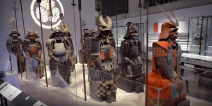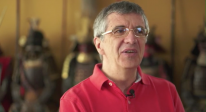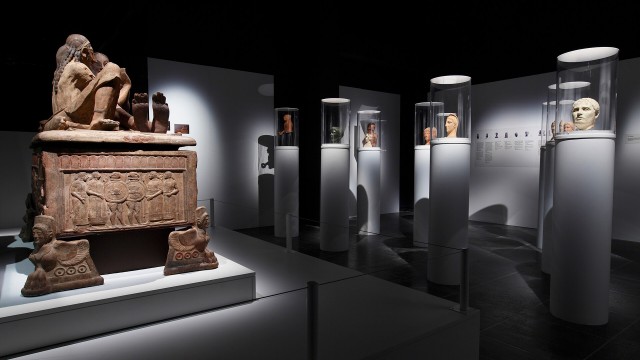Previous exhibition
May 17th, 2012 — March 31st, 2013
Samurai - The Prestigious Collection of Richard Béliveau
Well-known in Québec for his work in the prevention and treatment of cancer, Richard Béliveau is a university professor, researcher, author, speaker, and presenter, as well as a devotee of Japanese culture and a great collector of Japanese objects and artwork.
For the very first time, Mr. Béliveau has agreed to exhibit part of his vast collection. It is one of the most important collections in the world, both for its historical value and rarity, as well as in terms of the number and diversity of items it contains.
The samurai: courageous, and guided by a code of honour
Fascinated with Japan and the samurai, Richard Béliveau likes to reminds us that in addition to mastering their weapons, the samurai followed a code of honour. “This code, called Bushido, is based on seven virtues: loyalty, honour, courage, rectitude, honesty, respect and benevolence, together with a highly developed sense of aesthetics and well articulated spirituality. These are important values that can inspire us in our daily lives,” adds the Montréal collector, who is also a researcher, university professor, author, lecturer and television host.
The exhibition, which features 19 complete samurai suits of armour, 33 masks and 25 helmets, offers an introduction to this captivating universe through three major themes: The Way of the Warrior, The Way of Zen, and other Refined Ways. The objects presented in the exhibition are true treasures from the Azuchi Momoyama period, which stretches from 1573 to 1603, and from the Edo period, which began around 1600 and came to an end in 1868. Some of the objects are even older, dating as far back as the 13th century.
An army of samurai on display, dressed in their finest armour
Familiar figures in literature, film and comic books, the samurai have fuelled our imaginations with their epic battles, dazzling costumes and impressive armour.
Upon entering the exhibition room, visitors find themselves in a captivating environment featuring what is without a doubt one of the exhibition’s highlights: a platform on which ten samurai stand grouped together like an army, decked out in their finest armour and carrying their deadliest spears. This arrangement of noble warriors allows visitors to admire the details of their armour, each consisting of about ten pieces, made of hammered steel held together with silk laces, and their helmets made of lacquered leather or steel, or coated in silver. These are complete and authentic suits of armour from Japan—not reproductions—and are richly decorated and fashioned from high-quality materials. Their construction, too, obviously required great technical skill.
An exceptional collection of weaponry and very rare objects
The exhibition also features an exceptional selection of weaponry, including 18 spears and 20 swords, as well as several command batons. In addition to being very effective and deadly, these weapons are true works of art, and a tribute to the skills of the craftsmen who produced them. Among the exhibition’s rare objects are a series of red masks, a colour used to show ferocity and intimidate adversaries. Richard Béliveau owns one of the world’s largest collections of this type of mask. Three additional exceptional weapons are also on display: a very rare Nagamaki sword, a Naginata spear and an authentic Muramasa sword, a true Japanese National Treasure made by the famous swordsmith of the same name, renowned for the quality of his work. Several other pieces or groups of objects found among the samurai’s personal belongings are also on display to complete this portrait of the warriors’ lives.
The samurai: warriors and spiritual beings
The samurai were not only fearsome warriors, but also spiritual individuals pursuing an inner quest, attracted to asceticism and the strict dictates of Zen Buddhism. Many samurai adopted this religion, which was in keeping with their code of honour. The Way of Zen features a series of display cases and objects inspired by this approach. On display are a travel altar, prayer beads, scrolls and other objects that bear witness to Zen’s influence on the samurai.
Flowers, incense, calligraphy and tea: a life imbued with beauty
Another section of the exhibition presents a less-familiar face of the samurai, showing us that they were also great lovers of art, aesthetics and beauty. Well known for their heroism, the samurai were great warriors as well as patrons who enabled the Japanese spirit and Japanese art to flourish. The Way of the Sword is also that of tea, flowers and meditation.
Incense played an important role for the samurai, and burning it was spiritual and meditative. Several magnificent objects bear witness to this important activity. The samurai also practised flower arranging—ikebana—and calligraphy, and raised the tea ceremony to a true art form. This section of the exhibition includes vases, baskets, calligraphy scrolls, brush holders and wrist rests. Tea plays a key role in the exhibition, with several display cases focusing on the tea ceremony, explaining how tea is prepared, and featuring bowls, cups, teapots, early ceramics and even the tea bowl Richard Béliveau himself uses on a daily basis!
More to see and hear
In addition to the various groups of objects and pieces on display, visitors can also see excerpts from the five greatest masterpieces of Japanese film featuring samurai, and watch a documentary showing how blades are made using traditional Japanese forging techniques, with Quebecker Pierre Nadeau, one of the few people in the world to have received this training. Visitors can also hear Richard Béliveau’s commentary on the tea ceremony, and view magnificent images that highlight and underline inner strength.
A book to complement the exhibition (out of print)
To complement and complete the exhibition, the Museum has produced a richly illustrated book entitled Samurai. Exquisite Warriors, written by Richard Béliveau, published by Libre Expression, and available at the Museum Shop and in fine bookstores. This book is now out of print.
Year of the Samurai
All year long, many events complementing the exhibition will take place, including a series of talks at the Université de Montréal’s Les Belles Soirées (one of which will be presented by Richard Béliveau himself on October 10), Japanese inspired dishes on the menu at L’Arrivage restaurant, workshops for children, and tea served to visitors. In addition, starting on July 22 and continuing all summer long, there will be special activities on a Japanese theme every Sunday in Place D’Youville, outside the Museum.
About Richard Béliveau
A well-known and well-liked figure in Québec, Richard Béliveau, Ph.D. in Biochemistry, is the director of the Molecular Medicine Laboratory, and a researcher in the Department of Neurosurgery at Notre-Dame Hospital (CHUM). A seasoned researcher, he has published over 240 papers in various international medical journals. His primary research interests include cancer prevention and treatment. He is the author of the best-selling books Foods That Fight Cancer; Cooking with Foods That Fight Cancer; Eating Well, Living Well; and Death: The Scientific Facts to Help Us Understand It Better. Mr. Béliveau was the winner of the 2006 “Audience Award” at the Salon du livre in Montréal, and was named Personality of the Year for 2006 by L’Actualité magazine, and Québec Personality of the Year for 2007 by Au Québec magazine. An author, speaker, and co-host of the show Kampaï, broadcast on Radio-Canada, Richard Béliveau has a great passion for Japanese civilization.
During its presentation from May 17, 2012 to March 31, 2013, 244 200 people visited this exhibition.
Samurai — The Prestigious Collection of Richard Béliveau is produced by Pointe-à-Callière, the Montréal Museum of Archaeology and History, in collaboration with Mr. Richard Béliveau. Pointe-à-Callière thanks its sponsors: Astral, Japan Foundation, InterContinental Hotel, La Presse, and The Gazette.



